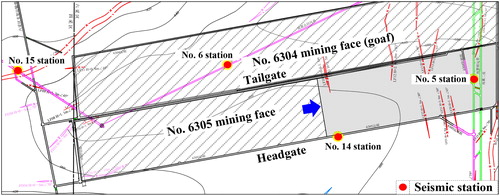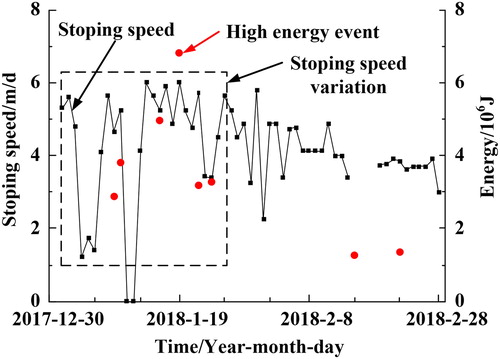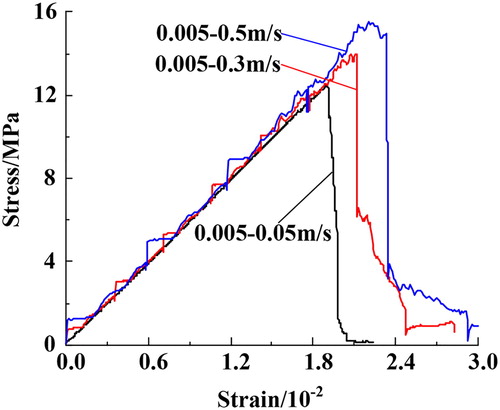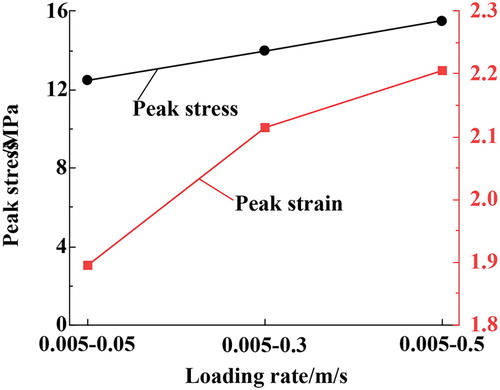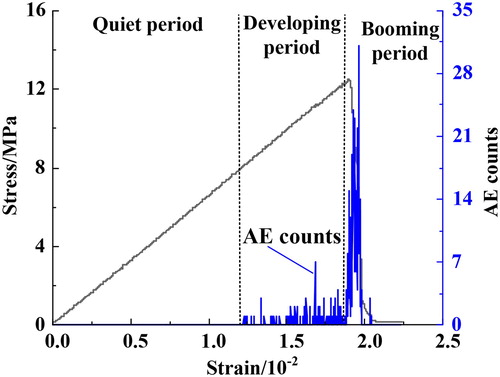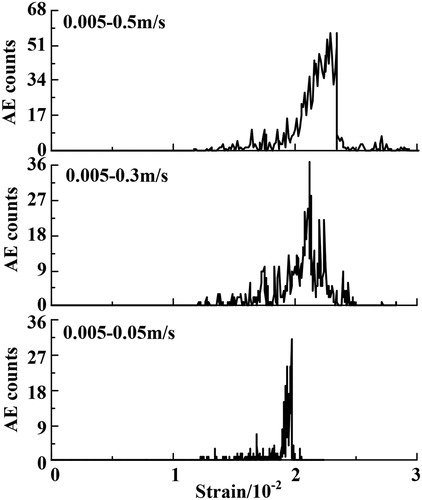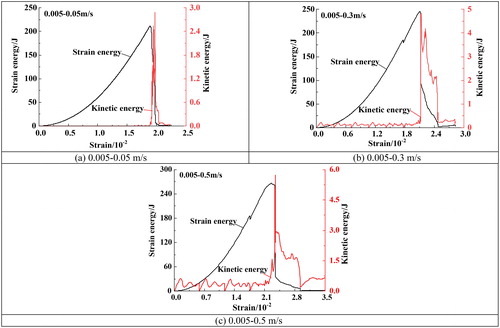 ?Mathematical formulae have been encoded as MathML and are displayed in this HTML version using MathJax in order to improve their display. Uncheck the box to turn MathJax off. This feature requires Javascript. Click on a formula to zoom.
?Mathematical formulae have been encoded as MathML and are displayed in this HTML version using MathJax in order to improve their display. Uncheck the box to turn MathJax off. This feature requires Javascript. Click on a formula to zoom.Abstract
Many field investigations have proven that the stoping speed of mining face is closely related to the amount of energy released from hard roof fracturing. Taking the Dongtan Coal Mine as the engineering background, we first analyze the relationship between the stoping speed and the microseismic activity. Then, the effect of the variable loading rate on the mechanical behavior of rock or coal is studied using PFC2D simulation. Finally, the occurrence mechanism of rock burst induced by the stoping speed variation under the hard roof condition is revealed. The stoping speed variation is not advantageous for the slow release of elastic energy stored in the roof and coal seam, and it can easily induce high energy events, which can reach 2.88–6.81 × 106 J. Under a variable loading rate condition, the energy storage capacity of coal and the released kinetic energy increase. When the stoping speed increases, the energy stored in the coal seam simultaneously increases, which implies that the dynamic balanced system is disturbed, and a rock burst may occur. When the stoping speed decreases, the new dynamic balanced system cannot absorb the entire pre-stored energy, and some of that energy will be released, which may also induce a rock burst.
1. Introduction
To improve the production and mining efficiency, many new methods, e.g. increasing the mining face length, stoping speed and mining height, are applied in coal mining in China (Guo et al. Citation2019a). The stoping speed can be easily controlled according to the mining engineering condition (Wang et al. Citation2012; Guo et al. Citation2017; Jiang, Gu et al. Citation2019). Field practice proves that the stoping speed is closely related to the ground pressure intensity. The loading–unloading activities of the surrounding rock under high stoping speeds are more intense than those under low stoping speed (Yang et al. Citation2016; Zhang et al. Citation2017; Jiang, Wang, et al. Citation2019). However, a slow stoping speed affects the high-efficiency mining. Thus, it is essential to study the stoping speed effect during coal mining.
Recently, scholars have conducted many studies in numerical simulation, theoretical analysis and field practice. Regarding numerical modeling, Xie et al. (Citation2007) and Wang et al. (Citation2006) examined the effect of the stoping speed on the surrounding rock stress, and found that the stress reduction zone and failure zone decreased with increasing stoping speed. Liu (Citation2010) noted that when the stoping speed increased, the peak stress and influencing range of abutment pressure decreased. Liu et al. (Citation2015) found that the development height, width and range of the overburden fracture also showed a decreasing trend. In theoretical study, Wang and Wang (Citation2015) established a fold catastrophe model of the main roof dynamic fracture for analysis, and they concluded that increasing the stoping speed was equivalent to improving the loading rate of the main roof and amplifying the strain energy stored in the roof, which caused the increase in kinetic energy proportion. Yang et al. (Citation2015) found that increasing the stoping speed increased the roof first caving interval by using the plate structure theory with laboratory test results. Regarding field practice, Cui et al. (Citation2011) noted that when the stoping speeds were 4 and 13 m/d, the corresponding weighting pace were 12.8 and 21.8 m, respectively. Wang et al. (Citation2012) analyzed the effect of a high stoping speed on the behavior of the periodic pressure at shallow mining depths, and concluded that the duration of the periodic weighting significantly increased. Li et al. (Citation2013) and Yin et al. (Citation2017) found that the magnitude and frequency of microseismic greatly fluctuated if the stoping speed suddenly increased.
These studies mainly focus on the effect of a high or slow stoping speed on the ground pressure, but under field engineering conditions, the stoping speed is not always constant. The effect of a variable stoping speed must also need to be considered. Thus, this paper first analyzes the relationship between the variable stoping speed and the released energy of the roof fracture in Dongtan Coal Mine. Then, PFC2D numerical modeling is used to study the effect of the variable loading rate on the mechanical behavior of coal or rock. Finally, the rock burst mechanism induced by the variable stoping speed is revealed.
2. Engineering geological conditions
The Dongtan Coal Mine is located in Shandong Province, China. The study area is the No. 6305 mining face, which is next to the goaf of the No. 6304 mining face, as shown in . The lengths of the headgate and tailgate are 1563 and 1580 m, respectively. The length of the longwall face is 253 m. The level of No. 6305 mining face varies from –632.1 to –676.5 m, and the average value is –658.4 m. The main mining coal seam is No. 3up coal seam. The longwall technology is adopted.
illustrates the lithological characteristics in detail. The thickness of the coal seam is 4.30–5.50 m with an average value of 5.06 m. The immediate roof is mudstone with a thickness of 0–1.6 m. The main roof is fine siltstone with 8.01–15.25 m thickness. The immediate floor is find sandstone with a thickness of 9.47–13.26 m. The main floor is fine siltstone with 6.05–13.73 m thickness. To investigate the relationship between the stoping speed and the microseismic events, the stoping speed of No. 6305 mining face were adjusted between January and February in 2018. During this period, the microseismic events were monitored.
Table 1. Lithological characteristics of the roof and floor.
3. Analysis of the microseismic monitoring results
3.1. Distribution of the high energy events
lists eight high-energy events larger than 106 J. All eight large-energy events occurred above the coal seam at 83–240 m high. The relationship between the stoping speed and the large-energy event is illustrated in . When the stoping speed greatly varied in the range of 1.4–6.0 m/d, the energy of each event is 2.88–6.81 × 106 J. The number of large-energy events is 6. When the stoping speed remained slow and steady in the range of 3.7–4.1 m/d, the energy is only 1.26–1.34 × 106 J. The number of large-energy events is only 2. The monitoring result reveals that the variable stopping speed is disadvantageous for the rock burst mitigation.
Table 2. Microseismic events larger than 106 J in the No. 6305 mining face.
3.2. Evolution law of microseismic activity
shows the relationship among the total energy, number of microseismic events and stoping speed. In January, when the stoping speed varied, the total energy was high and greatly varied, but the number of microseismic events was low. In February, when the stoping speed remained almost stable at 4.0 m/d, the total energy remained low and steady, but the number of microseismic events was high. This phenomenon indicates that a varied stoping speed is not advantageous to the slow release of energy stored in the roof, which causes the rapid increase in elastic energy stored in the coal. Thus, the coal wall may experience burst damages.
Figure 3. Relationship among the total energy, number of microseismic events and stoping speed (Zhao et al. Citation2018).
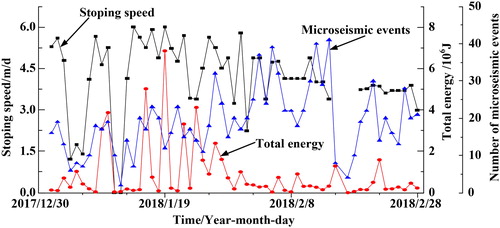
4. Numerical modeling on the mechanical behavior of coal under variable loading rate condition
It is difficult to study the effect of the stoping speed on the strength and failure characteristics of coal in the engineering scale, but the stoping speed variation is equivalent to the loading rate variation in the laboratory scale (Li et al. Citation2015; Yang et al. Citation2016; Guo et al. Citation2019b; Wu et al. Citation2019). Thus, this part numerically studied the effect of a variable loading rate on the mechanical properties, AE evolution and energy evolution of coal under the uniaxial compression condition.
4.1. Discrete element model and simulation scheme
In PFC2D, there are two bond models—the contact bond model (CBM) and parallel bond model (PBM) used to simulate granular materials and compact materials, respectively. In this paper, the PBM was selected. The size of the numerical specimen was height × width = 100 × 50 mm, as shown in . The average unit was 1800 kg/m3. The specimen consisted of 11693 particles, and the particle radius was 0.3–0.4 mm. lists the microparameters used in this numerical model.
Table 3. Microparameters of coal.
In the PBM, a micro crack formation will induce an AE event and release energy. The AE evolution law of coal can be simulated by recording the crack number and postprocessing the data. During the loading process, the method provided by reference (Tan et al. Citation2016; Guo et al. Citation2018) was used to obtain the effect of the variable loading rate on the AE evolution law. Equations (1) and (2) were used to monitor the evolution laws of the strain energy Ec and kinetic energy Ek during the loading process (Itasca Consulting Group Inc Citation2004).
(1)
(1)
(2)
(2)
where Nc is the number of contacts; |Fin|2 and |Fis|2 are the magnitudes of the normal and shear components of the contact force; kn and ks are the normal and shear contact stiffness values; and M(i) and v(i) are the generalized mass and velocity of each of the Np partices.
Three loading schemes were designed to study the effect of the variable loading rate on the mechanical behavior of coal: 0.005–0.05, 0.005–0.3 and 0.005–0.5 m/s. For example, with the variable loading rate of 0.005–0.05 m/s, the loading rate of 0.005 m/s follows 0.05 m/s, and 0.05 m/s follows 0.005 m/s, as shown in . The loading duration of each time is 5000 step.
4.2. Overall stress–strain curves
shows the stress–strain curves under different variable loading rates. Under the variable loading condition, the stress–strain curve still consists of the elastic stage, yield stage and post-peak failure stage. The strength increases with the increase in variation range of the loading rate. Additionally, the stress–strain curve exhibits a step feature due to the variation of the loading rate.
illustrates the evolution law of the peak stress and peak strain under different loading conditions. These two parameters increase with the increase in variation range of the loading rate. When the loading rate varies from 0.005–0.2 m/s to 0.005–05 m/s, the peak stress and peak strain increase from 12.32 to 15.57 MPa and 1.90 to 2.20 × 10−2, and the corresponding increasing rates are 26.38 and 15.79%. This result indicates that the increase in variation range of the loading rate enhances the energy storage capacity.
4.3. AE evolution law
Under the variable loading rate condition, the stress–strain curve is related to the AE counts. For example, with the variable loading rate of 0.005–0.05 m/s (), the entire stress–strain curve can be divided into three stages: I-quiet period, II-developing period, and III-booming period. In the quiet period, no events are recorded due to the elastic deformation. Then, the number of AE events gradually increases, which implies that the specimen enters the developing period and begins generating micro cracks. The booming period follows the developing period. During this period, the specimen fails, and the number of AE events is maximal.
illustrates the AE evolution law under different variable loading rate conditions. The duration of the booming period and maximum AE counts increase with increasing the variation range of the loading rate. When the varied loading rate increases from 0.005–0.05 to 0.005–0.5 m/s, the maximum AE counts increase from 31 to 57. The corresponding increasing rate is 83.87%. This result reveals that the released energy greatly increases with increasing variation range of the loading rate.
4.4. Energy evolution law
illustrates the AE evolution law under different variable loading rate conditions. Both strain energy and kinetic energy increase with the increase in variation range of the loading rate. When the variable loading rate increases from 0.005–0.05 to 0.005–0.5 m/s, the total strain energy and maximum kinetic energy increase from 211.75 to 266.12 J and 2.89 to 5.73 J, respectively. The corresponding increasing rates are 25.68 and 98.27%. This result proves that the increase in variation range of the loading rate enhances the energy storage capacity of coal and accelerates the dynamic failure. There is also another interesting phenomenon: when the variation range of the loading rate reaches a certain value, the kinetic energy will fluctuate before the specimen failure. This phenomenon may result from the unbalanced evolution of internal energy.
5. Occurrence mechanism of rock burst induced by the variable stoping speed
Scholars have shown that the stoping speed affects the stress distribution, damage degree, weighting step, etc., under the constant stoping speed condition. When the stoping speed increases, there are three characteristics of rock pressure (Xie et al. Citation2007; Li et al. Citation2013; Yang et al. Citation2015; Yang et al. Citation2016; Zhang et al. Citation2017; Wang et al. Citation2018). First, the stress relaxes, and the plastic zones of the roadway surrounding rock decrease. Second, the peak stress of the abutment pressure increases, and its location approaches the coal wall. Third, the roof weighting step and intensity increase. Thus, the surrounding rock structures under low and high stoping speeds are shown in . At low stoping speeds, we assume that the width of the plastic zone, hanging length of the main roof and peak stress of the abutment pressure are L1P, L1 and σ1max (. At high stoping speeds, we assume that the width of the plastic zone, hanging length of the main roof and peak stress of the abutment pressure are L2P, L2 and σ2max (). Then, L2P<L1P, L1<L2 and σ1max<σ2max, which implies that the elastic strain energy stored in the coal seam and main roof nonlinearly increases (Zhao et al. Citation2018). There are two cases of stoping speed variation: from low to high and from high to low. This subsection discusses the occurrence mechanisms of rock burst in the two cases.
Figure 10. Surrounding rock structures under low and high stoping speed. (a) Low stoping speed, (b) high stoping speed.

Figure 11. Occurrence mechanism of rock burst induced by the variable stoping speed. (a) From low to high, and (b) from high to low.

5.1. Stoping speed varies from low to high
When stoping speed is low, the width of the plastic zone is L1P, and the peak stress of the abutment pressure is σ1max. As illustrated in Section 3.2, a slow release of the strain energy stored in the roof and coal seam is desirable. The coal–rock system is in a dynamic balanced state. When the stoping speed rapidly increases, the width of the plastic zone remains constant, but the peak stress of the abutment pressure greatly increases, which implies that the energy stored in the coal seam experiences an instant increase of △Esc. Meanwhile, the hanging length of the main roof increases from L1 to L2, and the energy stored in the main roof increases by △Esr. The entire coal–rock system increases in strain energy (△Esc+△Esr), whose amount increases with the increase in variation range of the stoping speed. Thus, the dynamic balanced system is disturbed, and a rock burst may occur.
5.2. Stoping speed varies from high to low
When the stoping speed is high, the width of the plastic zone is L2P, and the peak stress of the abutment pressure is σ2max. When the stoping speed rapidly decreases, the peak stress of the abutment pressure decreases to σ1max, which implies that part of the energy △Erc stored in the coal seam will be released. Besides, the hanging length of the main roof decreases from L2 to L1, and part of the energy △Err stored in roof also releases. In other words, the released energy of the coal–rock system increases (△Erc+△Err), whose amount increases with the increase in variaton range of the stoping speed. Therefore, rock burst can be easily induced.
6. Conclusions
This paper first analyzes the relationship between the variable stoping speed and the released energy based on field monitoring, subsequently numerically studies the effect of the variable loading rate on the mechanical behavior of coal or rock, and finally reveals the occurrence mechanism of rock burst induced by the variable loading speed. The main conclusions are as follows:
A variable stoping speed can easily induce a high energy event, while low and steady stoping speeds can effectively reduce the magnitude and number of high-energy events. A varied stoping speed is disadvantageous for the slow release of elastic energy stored in the roof and coal seam.
Under the varied loading rate condition, the peak stress, stored strain energy and released kinetic energy of the coal or rock greatly increase with the increasing variation range of the loading rate. This result implies that the increase in variation range of the loading rate enhances the energy storage capacity and accelerates the dynamic failure.
When the stoping speed varies from low to high, the energy stored in the coal–rock system rapidly increases; when the stoping speed varies from high to slow, the released energy of coal–rock system rapidly increases. These two cases will disturb the dynamic balanced system of coal–rock, and rock burst can easily occur.
Disclosure statement
No potential conflict of interest was reported by the authors.
Additional information
Funding
References
- Cui TF, Zhang DS, Fan GW, Jiang YC, Wang XZ. 2011. Pressure behavior law and powered support suitability of high cutting coal mining face in shallow depth seam. Coal Sci Tech. 39(1):25–28.
- Guo WY, Gu QH, Tan YL, Hu SC. 2019a. Case studies of rock bursts in tectonic areas with facies change. Energies 12(7):1330.
- Guo WY, Tan YL, Yu FH, Zhao TB, Hu SC, Huang DM, Qin ZW. 2018. Mechanical behavior of rock–coal–rock specimens with different coal thicknesses. Geomech Eng. 5(4):1017–1027.
- Guo WY, Yu FH, Tan YL, Zhao TB. 2019b. Experimental study on the failure mechanism of layer-crack structure. Energy Sci Eng. 0:1–22.
- Guo WY, Zhao TB, Tan YL, Yu FH, Hu SC, Yang FQ. 2017. Progressive mitigation method of rock bursts under complicated geological conditions. Int J Rock Mech Min Sci. 96:11–22.
- Itasca Consulting Group Inc. 2004. Manual of particle flow code in 2-dimension (Version 3.10). Minneapolis (MN): Itasca Consulting Group Inc.; p. 3–6.
- Jiang BY, Gu ST, Wang LG, Zhang GC, Li WS. 2019. Strainburst process of marble in tunnel–excavation-induced stress path considering intermediate principal stress. J Cent South Univ. 26(4):984–999.
- Jiang LS, Wang P, Zheng PQ, Luan HJ, Zhang C. 2019. Influence of different advancing directions on mining dffect caused by a fault. Adv Civ Eng. 2019: 7306850.
- Li HD, Lan H, Du TT, Hou DJ. 2013. Micro-seismic characteristic and danger-relief method in rock-burst danger period of mining face under hard and thick roof of Kuangou Mine. J China Coal Soc. 38(S1):6–11.
- Li HT, Song L, Zhou HW, Jiang YD, Wang HW. 2015. Evaluation method and application of coal burst performance under the effect of loading rate. J China Coal Soc. 40(12):2763–2771.
- Liu QM. 2010. Analysis on mining velocity effect of mine pressure behavior of fully mechanized longwall coal mining face with shallow mining depth. Coal Sci Tech. 38(7):24–26.
- Liu HY, Chen YP, Zhou HX, Wang W, Zhang H. 2015. Guidance and control effect of drawing speed on excellent gas channel at fully mechanized longwall face. J China Coal Soc. 40(4):809–815.
- Tan YL, Guo WY, Gu QH, Zhao TB, Yu FH, Hu SC. 2016. Research on the rockburst tendency and AE characteristics of inhomogeneous coal–rock combination bodies. Shock Vib. 2016:1–11.
- Wang J, Ning JG, Jiang JQ, Bu TT. 2018. Structural characteristics of strata overlying of a fully mechanized longwall face: a case study. J S Afr I Min Metall 118:1195–1204.
- Wang JA, Jiao SH, Xie GX. 2006. Study on influence of mining rate on stress environment in surrounding rock of mechanized top caving mining face. Chin J Rock Mech Eng. 25(6):1118–1124.
- Wang JC, Wang ZH. 2015. Impact effect of dynamic load induced by roof in high-intensity mining face. Chin J Rock Mech Eng. 34(S2):3987–3997.
- Wang XZ, Xu JL, Zhu WB, Ju JF. 2012. Influence of high mining velocity on periodic weighting during fully-mechanized mining in a shallow seam. J China Univ Min Tech. 41(3):349–354.
- Wu QH, Chen L, Shen BT, Dlamini B, Li SQ, Zhu YJ. 2019. Experimental investigation on rockbolt performance under the tension load. Rock Mech Rock Eng. 10.1007/s00603-019-01845-1.
- Xie GX, Chang JC, Hua XZ. 2007. Influence of mining velocity on mechanical characteristics of surrounding rock in fully mechanized top-coal caving face. Chin J Geotech Eng. 29(7):963–967.
- Yang JH, Sun SL, Kong DZ. 2015. Effect of working face length and advancing speed on strata behaviors in high-intensity mining. Rock Soil Mech. 36(S2):333–350.
- Yang SL, Wang ZH, Jiang W, Yang JH. 2016. Advancing rate effect on rock and coal failure format in high-intensity mining face. J China Coal Soc. 41(3):586–594.
- Yin WL, Pan YX, Li ZH, Yan HP, Li GZ. 2017. Study on relationship between rock burst and microquake influence factor. China Saf Sci J. 27(2):109–114.
- Zhang HW, Li YP, Chen Y, Zhu F, Shao LF. 2017. Study on safety pushing forward speed of island coal mining face under hard roof and hard seam and hard floor conditions. Coal Sci Tech. 45(2):6–11.
- Zhao TB, Guo WY, Han F, Gu ST. 2018. Analysis on energy accumulation and release of roof under influence of mining speed. Coal Sci Tech. 46(10):37–44.

